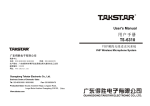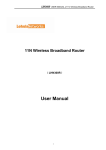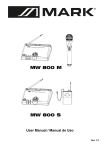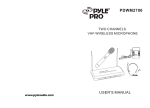Download Pyle PDWM8300 microphone
Transcript
TROUBLESHOOTING FOREWORD Some corem problems and their solutions are identified in the table below. If you are unable to solve a problem, contact your dealer. Problem No sound;RF light(s) not glowing No sound; R F lights glowing. Received signal is noisy c contains extraneous sounds sounds with transmitter on. Solution Make sure the transmitter POWER switch is ON and the receiver is plugged into a power source Check battery. Check receiver squelch setting. Check receiver antenna connection(s). Make sure antennas are in line of sight of transmitter. Turn up receiver audio VOLUME control Check for proper connection between receiver and karaoke unit Check battery Remove local. Sources of RF interference. If using a guitar or other instrument, check connections. Two transmitters may be operating on the same frequency. Locate and turn one off. Signal may be too weak Repositior~antennas. If possible, move them closer to transmitter. Thanks for purchasing our excellent wireless meeting microphone products,please read this instruction carefully so that you can understand how to operate the product you bought correctly, please store this book in the safe place for reference in future. Main features 1.Using VHF 170-270 Mhz band to avert interferencing frequency. 2.Using multilevel high frequency and mid frequency narrowband filter, so as to dispel any possible interferencing signals. 3.A specially designed circuit switch is on the phone.It is for clearing up waves of miscellaneous signals 4.All use quartz crystal oscillating circuits, so the frequency is very steady. 5.With audio compressing-expanding technology, the machine can lower noises and increase the dynamic range. It can also lower reecho. 6.It has channel separate outputing and mix outputing, and it can be connected with the sound-adjusting stage and the karaoke enlarge. 7.Special tone key locked identity functions to avoid interference signal from outside open the mute system. 8.There are mulriple noise detect circuit ,multi circuits, So it has strong anti-jamming specialty. 9.Uniform cardioid pickup pattern isolates the main sound source and minimizes background noise 10.Effective, built-in spherical wind and pop filter. 11.Longest distance in open :100m.Idealest distance in open: 50m Cautions Noise from receiver with transmitter off. Momentary loss of sound as transmitter is moved around performing area. Adjust receiver squelch control. Remove local sources of RF interference. Reposition receiver or antennas. Reposition receiver and perform another"walkthrough"test and observe the RF indicators. If audio dropouts persist, mark these"dead spots" in performing area and avoid them during performance. 8 1.Please ensure the host receiver in the place where is in good condition for signal, without dead angle. 2.Please keep the transmitter of microphone from throwing,casting, and so on, protecting from broken. 3.The reciever without water-proof, so please keep it from water or something like this. 4.Please keep distance with or away electromagnetic field,high voltage power net or big metal subjects. 5.Please switch off the transmitter when you change the battery. 6.Please put out the battery if you will not use the microphone for long time. 7.Please plug out the reciever if you will not use the microphone for long time. 8.Please get contact with the distributor of the products if there is problem on broken or something inside. 9.Please note we will not provide the service of repair if customer open it by themself without notice. 1 TECHNICAL PARAMETERS Unit Specification SYSTEM Operation Frequency range : 170-270.MHz VHF band Frequency stability : 0.005% Modulation : FM Frequency response : 40Hz-18KHz( 3dB) T.H.D : -0.8% Distance : 50-100M Temperture : -10-55 c 1.Please take the following working flow diagram for reference on using this machine-connect the mix out of receiver with mic input on the amplifier or out A,B,C,D and mic input on the amplifier. 2.Power 220V, switch the power, set the volume of your sound equipment. 3.Adjust the volume in right sound, make MIC1 and MIC2 harmony, which will make you enjoying the sound well. 4.Please plug out the power if you will not use the machine long time. System connection flow diagram RECIEVER MIXER AMPLIFIER Reciever Receiving system : Quartz crystal frequency Sensitivity : 10UV/40DB emf Removing weight : 50ms Audio output : 0-0.35Vp-p 5k Output connection : ¦6.3 mm plug Power supply : DC:12-17 V 2 KAROKE AMPLIFIER Installation of reciever Keep the machine 1m above the ground Keep the machine away 1m against the wall. Pull the antenna up rightness fully Make the transmitter point to the antenna without barrier Keep the reciever away any digital equipment(such as CD,VCD,PC.or other radio equipment) 7 FUNCTION DESCRIPTION TECHNICAL PARAMETERS Front Panel Handheld Transmitter 8 ways POWER 1 4 ways CH-A VOL CH-B VOL CH-C VOL CH-D VOL 3 3 3 3 2 1 VHF FOUR CHANNEL MICROPHONE SYSTEM 2 3 CH-E VOL CH-F VOL CH-G VOL CH-H VOL 3 3 3 3 4 4 + 1 - 2 +VOLUME - - 3 1.Power switch 3.Volume adjust 3 + 3 3 + 4 - Radio output power : >20mW Antenna : Hide inside Pre-weight : 50 uS Cartridge : Moving dynamic coil Battery consumption : < 30mA Battery life : 8 H time of duration Temperature range : -10 --55 ¡ POWER 3 1 2 2.Power indicator 4.Receiving indicator Body packing transmitter Rear panel 8 ways A N T:D ANT:C ANT:B ANT:A 1 1 12V 1 1 4 2.3 5 4 ways 1 1. Antenna 2 2 2 2 3 2.Audio output 4. balanced output 4 5 1 Radio output power : >20mW Carrying frequency : below the min carrying frequency 40dB Pre-weight : 50 uS Cartridge : condenser Battery consumption : <30mA Battery life : 8 H time of duration Temperature range : -10 --55 ¡ 3.mixed- balance output 5.DC power 6 3 TECHNICAL PARAMETERS TECHNICAL PARAMETERS Wireless meeting microphone Handheld transmitter ¢ This circle light is working, indicating the battery working when the transmitter is switched on. : : : : : : : : : : : : : DC9V <35mA 170-270MHz ¡0.002% >90dB > 80dB >80dB <3% Condenser noise proof Uni-direction 40Hz-18KHz( 3dB) -47¡3dB @1KHz -10-55¡ ¢ ¢ ¢ ¢ ¢Head net ¢Low voltage indicator ¢Power switch ¢9V Battery ¢Power light ¢Battery cover Laveliar transmitter Power indicator OFF LE INPUT Power switch D M IC Power supply Power consumption Carrying frequency Frequency stability S/N ratio Channel interference ratio Dynamic range T.H.D Cartridge Polarity Frequency response Sensitivity of transmission Temperture ON ON O FF 1 2 tie clip conjuction SS LE RE R L WI NE CEIVE AN CH E RE IN ON F TWROPH MIC VH OP EN VHF TWIN CHANNEL WIRELESS MICROPHONE RECEIVER VHF TWIN MICR CHAN OPHO NEL NE WIRE RECE IVER LESS OPEN OP 4 Operation 3 1.Cartridge collar line EN 2.Working indicator 3.Switch 4.Power and low voltage two color indicator 4 1.Please put the battery in the battery case correctly with right poles 2.Working when the switch on,mute at ST-BY 3.Please out out the battery and switch off if you will not use. 4.Please change the battery when the low voltage light is on 5












